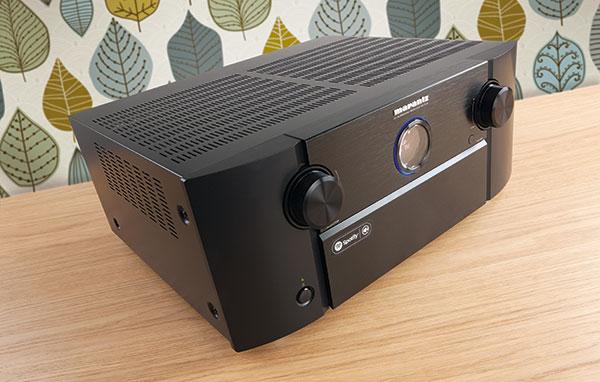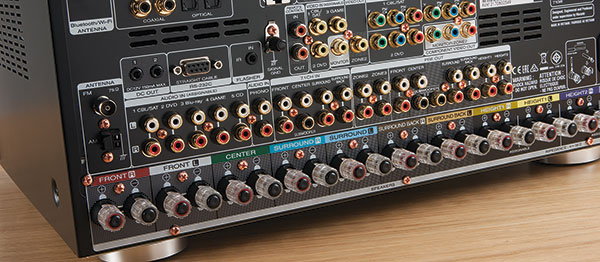Marantz SR7012 AV receiver review

 With Dolby Atmos, DTS:X and Auro-3D, Marantz’s SR7012 is one of a handful of receivers to boast this trio of sonic processing suites straight out of the box. One step down and, following a healthy price cut since its original launch, considerably more affordable than the brand’s flagship SR8012 AVR, could this £1,000 model be the sweet spot for object-based audio value?
With Dolby Atmos, DTS:X and Auro-3D, Marantz’s SR7012 is one of a handful of receivers to boast this trio of sonic processing suites straight out of the box. One step down and, following a healthy price cut since its original launch, considerably more affordable than the brand’s flagship SR8012 AVR, could this £1,000 model be the sweet spot for object-based audio value?
Well, if you're not hunting for 11 integrated channels, it may well be. Unlike the SR8012, this AVR has nine channels of power, so if you are setting up for something like 5.1.4 or the Auro equivalent, it’s good to go. To make full use of its 11-channel processing you will need an additional stereo power amp.
The rest of the spec sheet is AVR trumps gold. In addition to the headline processing, the SR7012 offers both DTS Virtual:X and eARC (the former promising object-based height projection from basic 5.1 or 7.1 speaker setups, the latter delivering object-based audio data back down from your TV), plus Bluetooth, Wi-Fi and hardwired Ethernet connections enabling a strong slate of networked features – including internet radio, streaming services, Apple AirPlay 2 and Amazon Alexa control. There's also HEOS support, allowing your cinema setup to become part of a HEOS multiroom setup.
Audyssey’s flagship MultEQ XT room EQ software is integrated, and for a £20 fee you can download Audyssey’s MultEQ Editor app, too. This gets you pretty much the full range of tools that were bundled as the much pricier Audyssey Pro Kit for installers.
For video, the SR7012 stocks an 8-in/3-out suite of HDMI 2.0 connections with Dolby Vision/HLG HDR passthrough. Should you still have legacy HD and even SD (tsk, tsk) sources, there is scaling to 4K from any video input.
Onboard amplification is touted at a very respectable 125W per channel (8 ohms, two-channel, 20Hz-20kHz), or an even more impressive 200W under a less rigorous measurement. With a nod to Marantz’s audiophile heritage, all nine channels use the company’s Hyper Dynamic Amp Modules (HDAMs), as found on the brand’s Reference series hi-fi separates. The circuit boards bristle with what Marantz describes as 'high-grade' components, and there's a Pure Direct mode that bypasses all but essential circuits for optimal performance.
Audio credentials are enhanced by 32-bit DACs and decoding for any format from humble MP3 right up to DSD and other flavours of hi-res. Strip out the AV gubbins and the SR7012 would make a very fine stereo amplifier.

Familiar setup
The Marantz’s setup will be familiar to anyone versed in the Audyssey measurement process. Hold fire, however. If you plan to use the Audyssey Editor App, you need to run the setup from the app rather than the AVR’s remote and GUI. While the Audyssey measurement and number-crunching is still done within the AVR, the app then uploads the data back to your smart device during the measurement process.
The Audyssey Editor App presents oodles of data, along with a plethora of target curves and adjustments to be fettled with. You can save many different setups and download them to the AVR as required. Different setups for different genres of film? No problem. The system also shows an in-room frequency response for each channel before and after Audyssey EQ. The ‘after’ curves shown in my setup were ambitiously flat compared to measurements using an independent RTA system.
No matter, though, because the SR7012 sounds pretty darn fine. Simply playing music to warm up for the main movie event is immediately impressive. The sound is clean, controlled and with the sort of expansive imaging that a stereo integrated amplifier would be proud of.
Firing up the other seven channels with Dolby Atmos material demonstrates an equally smooth and refined performance. There is no overt colouration to the sound that would give it a stand-out feature, like aggressive bass or frisky treble, just a well-balanced, even-handed approach to film mixes.
Tom Cruise’s distinctive tone is perfectly captured in The Mummy (Blu-ray). Subtler sequences are nicely enveloping and cosset you within the atmosphere of the scene. Early in the film, dialogue and ambient effects effortlessly put you in a large military transport plane. Set up as 7.1.2, I certainly missed only having two overheads for the Atmos mix, but it wasn’t a deal breaker.
As the action goes into overdrive about 10 seconds later, the Marantz picks up the pace. It peppers the room with detail and the LFE throb of a plane spiralling out of control. The roar of wind from the large hole in the fuselage rotates around my cinema, even if the sound of actors thumping into walls is far more Hollywood than reality.
It’s only when you start to get enthusiastic with the volume control during such chaotic audio scenes does the Marantz start to falter. With all channels driven it struggles to hit big SPL numbers. The sound stays remarkably solid and stable up to around 90 per cent of its full volume range, but you will likely see that figure if you want to scale to 100dB peak in-room. When I edged higher, I found the sound getting a whole lot harder through the mid-range, begging you to back it down.
A foray into using a 5.1.4 speaker setup arguably suited the Marantz even better than 7.1.2. This array added more height detail and made the soundstage feel more expansive at lower volumes too. Dense scenes within the City of a Thousand Planets, from Valerian... (4K BD) are suitably warm and stifling. Each neighbourhood is filled with its own charm, the Marantz missing little in bringing both the earthy grime and vibrancy to the film’s soundscape.
In general, the SR7012 acquits itself as a solid and sophisticated performer, if not an all-action monster. My Fifth Element 4K UHD reference Atmos disc is perfectly accurate and enjoyable but, when the scenes hot up, this does lack that last degree of grunt compared to more potent (and more expensive) AVRs. It's a better bet for smaller speaker packages and systems. Add to this the formidable feature set and stellar performance with stereo music, and it's warmly recommended.
Specification
Dolby Atmos: Yes DTS:X: Yes THX: No Multichannel input: Yes. 7.1-channel Multichannel pre-out: Yes. 11.2 phono Multichannel output (claimed): 9 x 125W (into 8 ohms) Multiroom: Yes. Zone 2
AV inputs: 4 x composite; 4 x digital audio (2 x optical and 2 x coaxial) HDMI: Yes. 8 x inputs; 3 x outputs Component video: 2 x inputs; 1 x output Video upscaling: Yes. 2160p Dimensions: 440(w) x 410(d) x 185(h)mm Weight: 14.2kg
Features: Auro-3D out of the box; Audyssey MultEQ XT; optional Audyssey Editor app; ISF video calibration; Marantz Remote app; Amazon Alexa control; eARC; Apple AirPlay; HEOS multiroom compatible; Ethernet; Wi-Fi; Bluetooth; USB; dual subwoofer outputs; Hyper Dynamic Amplifier Modules (HDAMs); MDAX2 compressed audio enhancer
 |
Home Cinema Choice #351 is on sale now, featuring: Samsung S95D flagship OLED TV; Ascendo loudspeakers; Pioneer VSA-LX805 AV receiver; UST projector roundup; 2024’s summer movies; Conan 4K; and more
|






















































